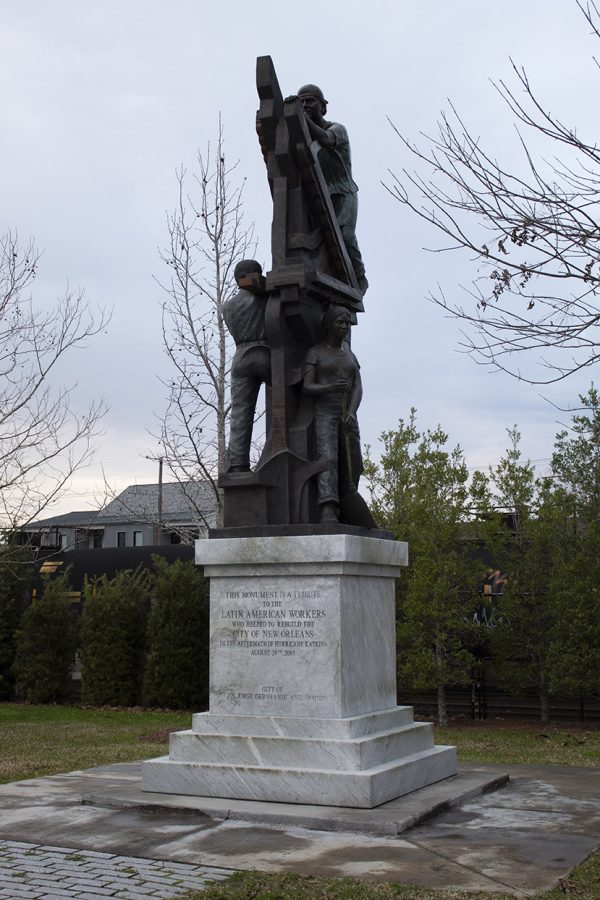EDITORIAL: It is time to make some monumental changes
March 17, 2023
Monuments are perfect examples of something that can exhibit culture and history, but don’t necessarily have to define it. So it’s no surprise to people who learn about the establishment of hundreds of Confederate statues in America by neo-Confederates after the Civil War, mostly during the height of the Ku Klux Klan. Choosing harmful figures to monumentalize is a projection of closed-mindedness and compromise. Statues in a city should reflect both national and local leaders, and those leaders need to reflect the values that we respect. We shouldn’t let our enemies spew hatred in our communities. Now that there have been concerted efforts to remove and replace these statues, we are left to question what we should replace them with.
When the Robert E. Lee statue was taken down from the former Lee Circle (now Harmony Circle) there was speculation about what would replace it. Now, six years later, we still do not have a replacement statue. New Orleans mayor, LaToya Cantrell, has hoped a decision will be reached by the end of her term, but it shouldn’t take this long to put a replacement statue up.
The time to get it done is now.
One possible creative solution is to have a rotation of statues, as well as the support of education centers about the monuments and their history. A rotation of statues could elevate Harmony Circle from a dissatisfactory image to a new cultural center incorporating New Orleans’ authenticity.
Beyond Harmony Circle, there are a plethora of streets that have harmful or racist names, with the majority of them named after Confederate figures. Ogden Street is one, named after a Confederate general Frederick Ogden who helped lead an attempted coup d’etat against the Reconstruction Era state government. This shouldn’t come as any shock from a state that has produced and given political power to a former grand wizard of the Ku Klux Klan, self-identified, racist and anti-semite, David Duke. Not to mention the notorious racially motivated gerrymandering meant to diminish the Black vote.
We already have some examples of positive recognition. The Holocaust memorial downtown blends creativity with a proper recognition. Cultural icon Louis Armstrong has received much appreciation through statues and his namesake in the airport. The statue unveiled in Crescent Park honoring the heroic Latino workers who helped rebuild New Orleans following Katrina should guide us in this replacement effort as well.
Much like the statue replacements, the process of renaming streets has gone unfinished too. One instance is the potential renaming of Calhoun Street, named after South Carolina politician John Calhoun, an ardent supporter of southern sectionalism and slavery. It was recommended by the Street Renaming Commission to rename the street after Father Louis J. Twomey, a Loyola graduate that pursued racial and worker justice. Replacing a racist who had no connection to New Orleans with a local justice advocate is perhaps the perfect guide for replacing statues. As members of the Loyola community, we should push for this.
These efforts touch us not just because we are an institution in New Orleans, but because they have permeated our interior. Many of the rooms in the Danna Center are named after enslavers and harmful figures – including the rooms “Audubon,” “Claiborne,” and “Napoleon.” This bubbled over into student opinion, leading the Student Government Association to pass a bill to have these rooms renamed.
One of the reasons it has taken so long is because people with Confederate sympathies have tried hard to resist this change. This is something we see all across the country as well. Their most frequent argument is that it represents “southern heritage.” It represents the preservation of slavery and Jim Crow laws. Additionally, the Confederate battle flag was adopted as the party flag by Dixiecrats in the 1940s, a party that was formed in response to President Truman’s executive order 9981, which integrated the armed forces.
Confederate imagery has always stood to represent slavery, the fight against civil rights, and specifically, white-nationalist heritage. Full southern heritage, not just white southern heritage, includes the fight against racial oppression, through sit-ins, the Little Rock Nine, and beyond. Preservation of Confederate imagery is not a matter of an extremely short lived Confederate legacy, but more so of everlasting racist nostalgia.
We need to take down racist statues and honor our real heroes. We don’t need to be honoring old traitors. France doesn’t give thanks to their World War II traitor Philippe Petain. Why should we honor ours?
Erecting monuments is a chance to celebrate both each other and our values as a community. We need to celebrate the people who truly represent who we are, not what we used to be. If our statues and monuments are inclusive and represent all of New Orleans, the city will be all the more welcoming, which is crucial during a period of declining population and relevancy.









